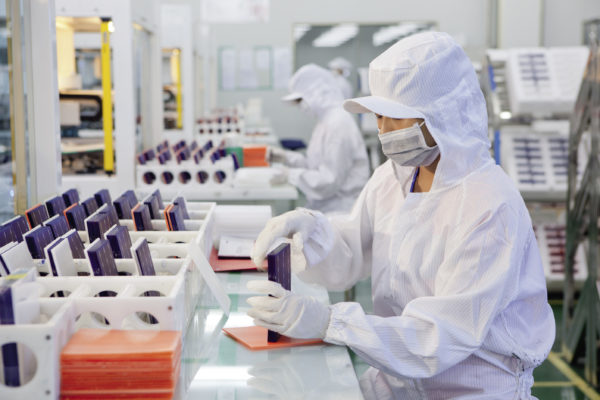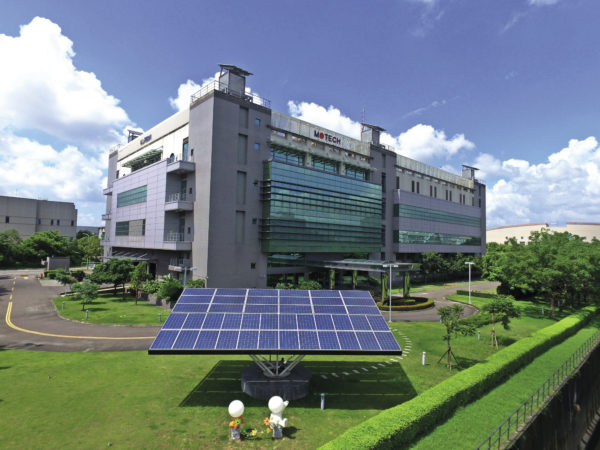It has been an exciting autumn for advancements in Chinese solar cell technology. In October, Longi Solar – newly christened earlier this year as a tier-1 PV module supplier by Bloomberg New Energy Finance (BNEF) – revealed that Germany’s Fraunhofer ISE CalLab had verified its 22.71% conversion efficiency record for monocrystalline passivated emitter rear contact (PERC) PV cells. But just several days later, JinkoSolar nimbly stepped in to steal its thunder. Mere weeks after it announced a new 22.04% efficiency record with its p-type multicrystalline silicon solar cells, the company punched back at Longi with a record 22.78% rate for mono PERC, as confirmed by the Chinese Academy of Science Testing Laboratory.
But the final touch was yet to come, as the Jiangxi-based PV group wasn’t quite finished. Underscoring the rapid technological advancements that Chinese cell manufacturers have racked up in recent years, JinkoSolar further upped the ante in early November by reporting a new mono PERC conversion rate of 23.45%, as confirmed by Fraunhofer ISE.
Following a year of blockbuster PV cell output capacity expansions throughout the global industry – largely led by Chinese companies like Longi and Tongwei Solar – the message is now clear. Cell manufacturers in the world’s biggest solar market, such as JinkoSolar and JA Solar, are no longer really playing second fiddle to Taiwanese producers in terms of cell quality and output, particularly with mono PERC technology.
“If you wanted to make good, highly efficient modules, you had to buy cells from JA Solar or Taiwanese companies – that was the situation before 2016,” explains independent solar analyst Corrine Lin. “But since then, pretty much every Chinese cell company – like Tongwei or Suntech Power – they can provide the same efficiency as Taiwanese cell companies.”
Efficiency gap
Taiwanese manufacturers still enjoy a slight advantage with PERC cells, Lin acknowledges. She estimates that most PERC cell producers on the island are currently clocking in with conversion efficiency rates in the range of 21.3% or 21.4% at mass production. Whereas in China, Lin gauges the average cell conversion efficiency rates in the 21.2% to 21.3% range.
“But it’s not that big a gap, because if you’re going to the module, it’s actually quite the same,” she says, noting that suppliers on both sides of the Taiwan Strait are now more than capable of squeezing out 295 W per module or more. “Taiwanese producers have an average efficiency that’s 0.1% higher than Chinese companies, but it’s not important.” Beijing’s Top Runner program – the quality-enhancement scheme that was introduced in 2015 to lower the levelized cost of energy (LCOE) of solar and facilitate the deployment of high-efficiency PV modules – has undoubtedly been an important factor in helping Chinese cell manufacturers to close the gap with their Taiwanese rivals in terms of cell efficiency, particularly for mono PERC. And the surge in Chinese demand for lasers used in PERC production equipment has been one of several developments that underscore the technological advancements the country’s manufacturers have steadily achieved in recent years, according to TeraSolar Energy Materials Corp. (TSEMC).

Image: JinkoSolar
A company spokesperson told pv magazine that since 2015, TSEMC – a Taiwanese supplier of conductive pastes and laser graving production kits, based in Taiwan’s Miaoli county – has delivered PERC lasers to Chinese customers to produce more than 7 GW of PV capacity.
“Almost all the Chinese solar cell makers – first-tier and second-tier – installed PERC production lines in gigawatt scale by this year,” the spokesperson said.
Jessica Jin, a senior analyst for IHS Markit, agrees that the efficiency gap between Chinese and Taiwanese cell manufacturers is a non-issue, describing that difference as “minimal” at this point. Although Taiwanese players embraced PERC cell architecture much earlier than their Chinese rivals, “the Chinese are upgrading more aggressively” at this stage of the game.
“The whole situation is changing now,” Jin tells pv magazine, explaining how Chinese government policy has been a key driver of this shift. “Last year in China, many cell producers upgraded their production to PERC to meet Top Runner requirements.”
Surging demand
This rapid shift to higher efficiency cells in China is already evident on the module side, according to Jin. In recent years, average PV module output has improved by about 5 to 10 W per year, she claims. “But this year we’re seeing a 10 W to 15 W increase,” Jin says. “That’s mainly contributed by PERC technology upgrades.”
As output has spiked at the module level, the Taiwanese have continued to enjoy an approximate 5 W advantage over their Chinese competitors with p-type cells. Jin partly attributes this to different aspects of the module production process, pointing to upgrades from three to four busbars and beyond as one of several production-level examples that have given the Taiwanese the edge on the module side over the past two to three years.
However, the Chinese are now chipping away at Taiwan’s advantage on the module side, too. For example, China’s Trina Solar – which has already introduced innovations such as half-cut cell technology into its Splitmax panels – plans to start producing a 12 busbar version of its mono Honey modules by the end of this year.
TSEMC has claimed total shipments of 4 GW of selective emitter (SE) lasers for PERC production kits this year too, largely on the back of surging Chinese demand for higher efficiency cells and modules. It believes that the integration of PERC and SE lasers is the next step in the development of higher efficiency solar cells. A company spokesperson – noting that tier-2 module manufacturers in China are now cautiously wading into PERC production at the megawatt scale – argues that optimization of the manufacturing process will be “critical for newcomers.”
Now in its third phase, the Top Runner scheme continues to facilitate the development of high efficiency PV cells in China. “The change was quite big this year and one of the biggest impacts was from Top Runner,” says Jin at IHS, explaining that the Chinese market is now more focused on how higher cell output can contribute to output gains in projects. “We see more and more people really caring about the LCOE of modules.”
Building reputations
Nonetheless, the degree to which recent PV cell advancements have contributed to better solar projects remains highly debatable. Jin says that cheaper modules are still widely used in utility-scale PV developers throughout the country, although she adds that demand for higher-efficiency solar panels – particularly mono PERC modules – has “definitely” jumped this year.
Lin concurs that Top Runner has played a role in driving everyone to PERC. She points to how Chinese manufacturers such as Longi Solar – which BNEF named as a tier-1 supplier earlier this year – have used the program to rapidly build its reputation in the market as a leading supplier of mono PERC modules. And as it is still early days for module-side innovations such as bifacial and half-cut cells, PERC has quickly edged out high efficiency technologies such as heterojunction cells as the best way for Chinese manufacturers to hit the Top Runner targets.
“Before Top Runner, Lerri [Longi] was something of a nobody… Nobody knew they could provide good modules,” Lin says. “PERC is a really good technology – [module manufacturers] can easily reach these government targets with PERC technology, so everyone has invested.”
On the distributed generation (DG) side, Lin does not see DG build-out as a significant driver at this point, despite modest deployment in C&I and residential projects over the past year.
“But more investors are familiar with high efficiency products now,” she says. “So maybe next year we will see more high efficiency products in the
DG market.”

This content is protected by copyright and may not be reused. If you want to cooperate with us and would like to reuse some of our content, please contact: editors@pv-magazine.com.
